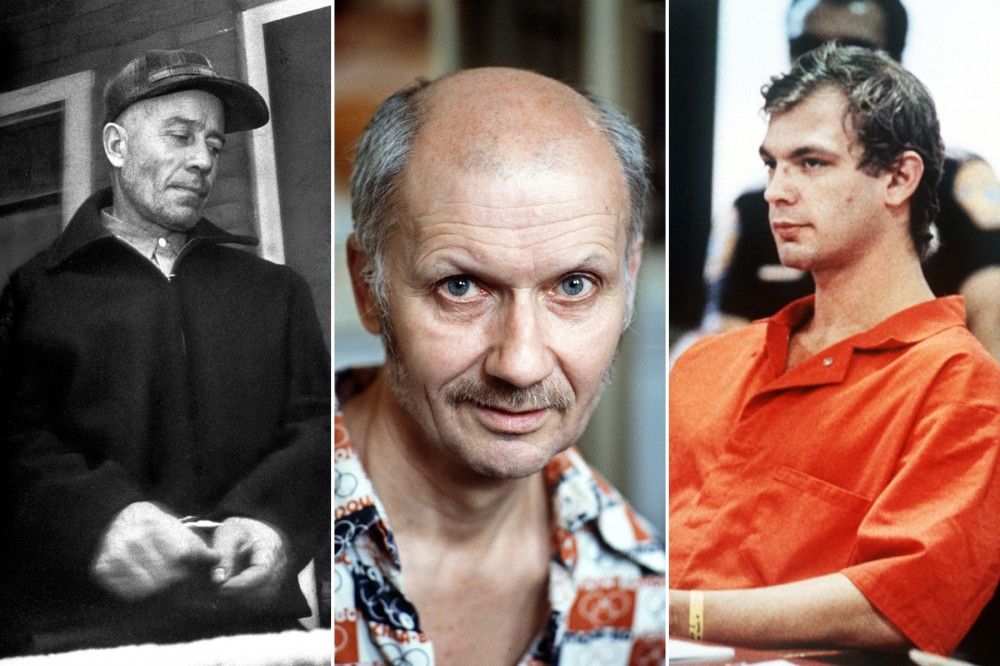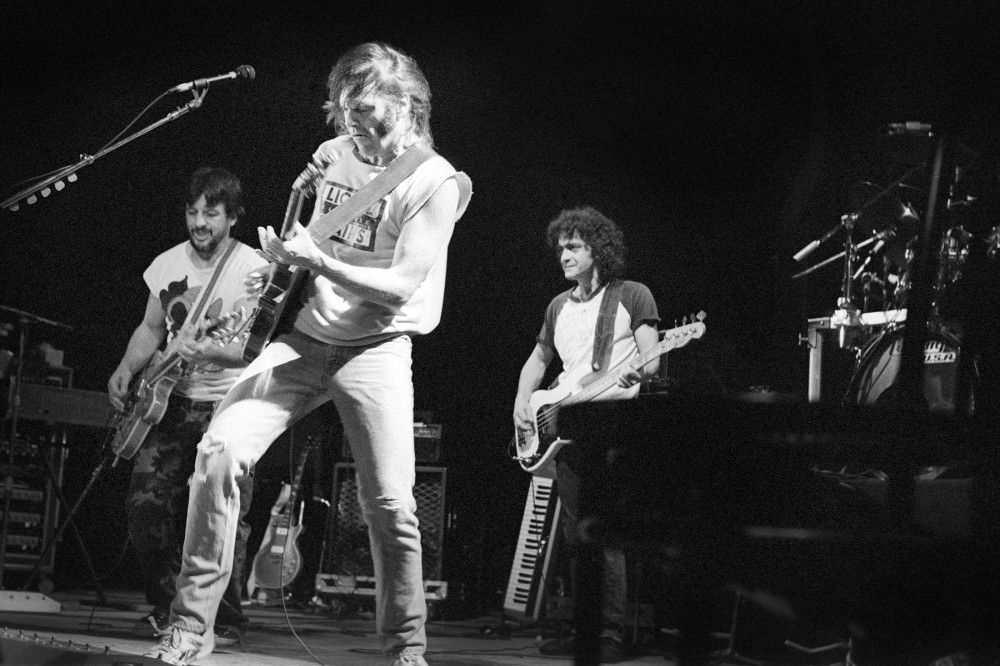
'Last Book on the Left' Cuts Serial Killers Down to Size
One of the most troubling problems with the genre, if you ask the hosts of the megahit Last Podcast on the Left, can be summed up with the 2019 Netflix docuseries Conversations with a Killer, or, as co-host Marcus Parks calls it, “That fucking Ted Bundy series.” Parks and his Last Podcast co-creators frequently deride the documentary — as well as Extremely Wicked, Shockingly Evil and Vile, the contemporaneous biopic starring Zac Efron — for making the seem brilliant and suave, while glossing over less-appealing details. “I think it’s important to show this is exactly what this person did,” Parks says. “It’s not cute, it’s not sexy. Ted Bundy was a necrophiliac who went back to the bodies multiple times as they were decomposing and putrefying and had sex with those bodies again and again, and that documentary, to the best of my memory, did not mention that.”
Since 2011 — three years before Serial launched the crime podcast frenzy — Parks and his co-hosts, comedians Henry Zebrowski and Ben Kissel, have never skimped on details of all things macabre and creepy, covering aliens, cults, the paranormal, and of course notorious murderers on Last Podcast on the Left. Typically, Parks tells the story, keeping the narrative moving forward, while Zebrowski does character impressions, and Kissel reacts and riffs with Zebrowski on the fly, trying to crack Marcus up. Dick jokes abound — a rarity in the female-dominated true-crime podcast genre.
But amid nearly a decade of raunchy humor, the hosts have developed a mission to eschew the glorification of killers. The trio, through deep research and cutting humor, present larger-than-life criminals in a different light: as mentally ill teens who should’ve been given help, elitist know-it-alls who you would’ve hated to have a college class with, or pathetic losers who refused to find something productive to do with their angst. They cut monsters down to size.
What started as a project by three horror movie fans in the basement of a Mexican restaurant in New York has become a phenomenon with more than 11 million monthly downloads, its own podcast network and a distribution deal with Spotify. The series recently passed its 400th episode, and Parks says the creators have a list of ideas long enough to do 400 more. “We’d love to keep the show going another five, ten years,” Parks says. “We love everything about doing it.”
Now the trio has released The Last Book on the Left, a fully illustrated compendium that revisits in print nine of the most notorious killers covered on the podcast, re-investigating the subjects and going through two rounds of fact-checking to provide definitive accounts of murderers from John Wayne Gacy to the Son of Sam to Soviet serial killer Andrei Chikatilo, which at the same time question their mythical status in our collective psyche and nightmares. Parks spoke with Rolling Stone about the research process, finding comedy in murder, and why most killers are really just losers.
Tell me about your goals for this book.
What we wanted to do with the book was go back to the biggest names in true crime and give each a full account, give all these stories a new perspective, and add our voice to the true crime conversation. For example, talking about Jeffrey Dahmer through the lens of personal responsibility for your own mental health combined with white privilege — the fact that Dahmer could’ve gotten help again and again but refused it. He is considered the most sympathetic of the serial killers. Editor’s note: Dahmer, a loner, told investigators he killed 17 young men and boys, almost all poor and people of color — and dismembered and ate parts of them, and committed acts of necrophilia — because he “didn’t want them to leave.”] Looking at it now, you see that Dahmer in actuality is not sympathetic. He’s the example of the one who could have gotten help and could have chosen a life that was not dedicated to destruction, and he just didn’t, and then tried to flip it for sympathy and a lot of people fell for it.
Was it always part of Last Podcast’s mission to flip the narrative on how we think about these mythologized criminals?
It was not necessarily a mission for us at first, like, “We’re gonna take these people down.” But I do feel great about tearing down these monsters. It was more of a realization. Once we started really getting into the stories of these characters, reading , reading unedited transcriptions of these people talking, that’s when we started to realize these guys are absolutely pathetic. They’re just dipshits. Of course there’s something terrifying in what they do, but as people, pathetic is as good a word as any to describe it. It’s in that nature — that pathetic nature — where the comedy lies.
Oh yeah?
The reason we started getting so much into research, at first, was about the jokes. There’s no comedy in broad strokes with these guys. It’s all about the details, but for those details to make sense you have to know the entire story. In order for Zebrowski and Kissel] to make a joke about a specific detail I have to give a lot of background information.
In the book, when it comes to Ed Gein, my research assistant Annie Powers looked into the Plainfield, Wisconsin, birth records, and she’s the one that found that the last names Gee and Dingledine might’ve been combined to make the name Gein. We don’t know that for sure, and it’s not necessarily important to the story, but Dingledine is a funny name, so it’s like a perfect example where the research turns into a joke.

What makes something a Last Podcast story? What catches your attention makes you want to learn more, and what makes it right for the show?
Narrative, first of all. There has to be a story to it with a beginning, middle, and an end. There has to be a level of absurdity to the story for the guys to be able to make jokes, and I think that’s really the two biggest things. I grew up in Texas and we don’t do a whole lot of Texas stories because they’re just dark. Texas true crime is very serious.
What else isn’t a Last Podcast story?
Being boring. We actually ran into this very recently. About two months ago, we were gonna do Harold Shipman. Harold Shipman is the most prolific English serial killer of all time. He has a body count of 250 to 300 — somewhere around there, we don’t know for sure. He was a doctor who euthanized patients, sometimes for money, sometimes, people think, it’s possible it psychologically had to do with his mother being terminally ill when he was young. But it’s just fucking boring. He was a boring person. We went through it and we were like there’s nothing here. He just killed people. And he did it for the most boring motive. Money is an exceedingly boring motive for anything, not even just murder. So that is the cardinal sin: boredom.
How do you divide up the prep for a show?
It is between me, Henry, and our team of five research assistants. They were necessary to hire because I got burnt out reading all the books and organizing all the notes, especially when we started working on the book.
So we have a research assistant tackle a couple of books. They’re weeks ahead of us, in some cases months, so they can send everything to us before we begin the week. They do the nuts and bolts thing, putting information in chronological order for me to refer back to when I’m writing a narrative. Then I will read a book and do extra research, Henry will read a book and do extra research, and Henry and I will talk throughout the week, at least twice, sometimes more, to come up with the narrative, find our point of view, discuss how we can make this special and make it ours. Henry does just as much research as I do. In order for anybody to really make jokes about something you have to know it frontwards and backwards. For him to come up with the characters he comes up with, he has to know the world these people live in, everything about these people. That’s how he’s able to do it. And Ben is the everyman. He is just naturally funny. His training is in standup comedy. Ben comes in fresh, and that’s by design.
You do mainly secondary research, it sounds like, reading books that have been written about cases and other events. Is that a time constraint or a choice for the show, that you’re not pulling case files or interviewing surviving family members?
It’s a time constraint. I’d love to do stuff like that. Almost all this stuff is written in books. The authors do what I consider the “real research,” going down to the library and going through hours of microfiche, reading every police report in detail, going and interviewing people. I would love to one day write a book where I find that case, and I do the primary research, and it’s something completely new. I’d love to do that, it’s just having the time. For right now, secondary research is a good way of putting it.
How do you avoid the trap of plagiarizing someone else’s story? What makes your approach your own?
I don’t really know! We’re very honest with where information comes from. And I guess it’s because I’m writing the story for Henry and Ben and writing with a point of view. Going with exactly what others have written is sort of boring. It’s gotta be interesting. In addition to making jokes, we have to make some sort of sense of this whole thing. It’s very difficult to do, but it is a goal.
This interview has been edited for length and clarity.



